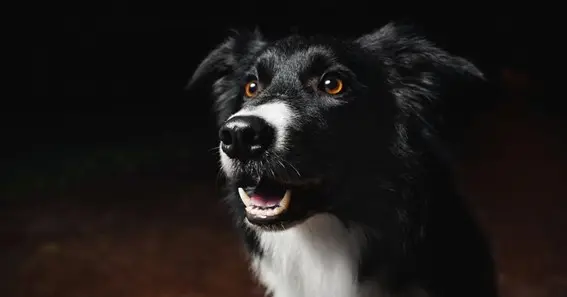What does the statement refer to—Can dogs see in the dark? Dogs can see in the dark more than humans since they possess more rod cells in their eyes, which are usually sensitive to low light. Also, their eyes contain a reflective structure known as the tapetum lucidum, which works by reflecting light via the retina, helping them see in the dark. Stay tuned to know more about can dogs see in the dark in the below post.
Can Dogs See In The Dark?
Dogs can see in the dark, but this is in a limited sense, given that they cannot see perfectly when it is pitch dark. Their eyes adapt to low light conditions even better than human eyes because their eyes have many more rod cells. Further, animals, including dogs, also possess an additional layer of cells called the tapetum lucidum, which illuminates the light to improve their ability to see in the dark. This enables dogs to secure better vision at night than humans, yet they cannot adapt to typically dark environments without light.
Post-reading this para about can dogs see in the dark reader will get a short idea about the topic.
Dogs have superior night vision compared to humans, thanks to the tapetum lucidum and other specialized eye structures that amplify available light.
Enhanced Night Vision in Dogs

It is important to note that the night vision of dogs is better than that of human beings, and as such, this attribute plays a vital role in determining the number of hours a dog is active at night. Scatter lamps are more active and self-assertive in low light conditions than other lighting conditions because this taps into their unique ability to detect motion within their environment.
This increased clarity is helpful for functions like guarding, foraging, and roaming at night-time. Further, it helps them to focus on such threats or unknown objects that may be present during the period of darkness, thus enhancing their alertness and vigilance at night.
The Reflective layer in a dog’s eye enhances night vision
Below the retina is another tapetum lucidum layer, which helps a dog see better at night. This layer is positioned behind the retina and bounces the light that transmits through the retina back into the eye, giving the photoreceptor cells a further chance to absorb the light. This adaptation makes them more suitable for experiencing night vision than their master, making dogs more mobile during night hours. The tapetum lucidum is also responsible for that shimmer or reflection in the dog’s eyes when the eyes catch the light when it is dark.
Evolutionary adaptations in dogs for night vision

Generally, the evolutionary changes in dogs to make them more suitable for various environments have also prepared them for situations such as night hunting. Over time, the main features that benefited were:
Enhanced sensitivity to motion and contrast.
The presence of a more significant number of rod cells.
The tapetum lucidum.
These adaptations enable dogs to search for prey and potential molesters and get around in the dark, as may have been the tradition in early hunting and foraging in the early morning and evening. While many of these evolutionary benefits are extremely useful today, dogs rely on them as they are now domesticated pets and working animals.
Common misconceptions about dogs ability to see in the dark
However, dogs have much better night vision than people, though some misconceptions still crop up about dogs’ night vision. A widely-held misconception is that dogs can see well in complete darkness, similar to some species of night-time animals. Nevertheless, for the same night vision as humans, which is far superior to that of a human eye, they are still affected by pitch black. Notably, another typical misconception is that all dogs have the same ability to see during the night, disregarding specific eye formation and genetic profile differences. Also, there is information that dogs navigate in the dark only by using their eyes, without considering their ears and noses.
Role of rod cells in night vision

Rod cells, responsible for vision in low light, are located in the retinas of a dog’s eyes and allow the dog to have night vision. Rod cells are the specialized photoreceptor cells, present in a more significant number in the dog retina than in the human retina. They are most sensitive to intensity changes and motion, enabling the dog to detect shapes and movements even in carving conditions. While rod cells did not sense colours, they offered enhanced sensitivity for seeing in the dark and hunting at night. This adaptation, along with other methods, such as the presence of the tapetum lucidum, can significantly enhance a dog’s vision at night.
On a closing note in the article about can dogs see in the dark we get to know the important role of rod cells which enhances the vision of dogs.
Conclusion
In conclusion of the article can dogs see in the dark, dogs have morphological adaptations that include the ability to see in the dark better than humans due to a higher density of rod cells and the tapetum luciduam. Although dogs cannot see in complete darkness, their vision under low-light conditions is way beyond the abilities of humans. Developing these biochemical products enhances dogs’ ability to live and function in areas with little light.
FAQ
Does the dog have the ability to see in the dark?
Dogs cannot see in pitch black, but they can certainly see much better than men in light areas.
What assists the eyes of dogs at night?
Dogs, for example, contain more rod cells in their retina and the reflective layer of the tapetum lucidum, which empowers their night vision.
What is the nature of the readiness of all dogs?
This depends on the breed of the dog or the specific dog the person has.
What could be the reason behind having a bright red eye when the surroundings are pitch black?
The actuality is that the cells of the eyes start to reflect light, which is why their eyes seem to glow in the dark.
Besides vision, how do dogs move around in dark or poorly lit environments?
Since dogs’ vision and hearing abilities are relatively sensitive, they depend heavily on their olfactory organs in such conditions.
At what age do dogs have the worst vision at night?
Indeed, reduced night vision can be caused by old age, cataracts, or a weakened retina.
Are dogs able to do colour vision during the night?
Well, dogs are known to have a dichotomous vision of grey or black and white, mostly at night, since low-light conditions do not allow rod cells to detect colour.
Check out this insightful post heart-of-palm-protein
Sources:
https://www.akc.org/expert-advice/lifestyle/can-dogs-see-in-the-dark/
https://www.petmd.com/dog/general-health/can-dogs-see-dark
https://www.southernliving.com/culture/pets/can-dogs-see-in-the-dark










